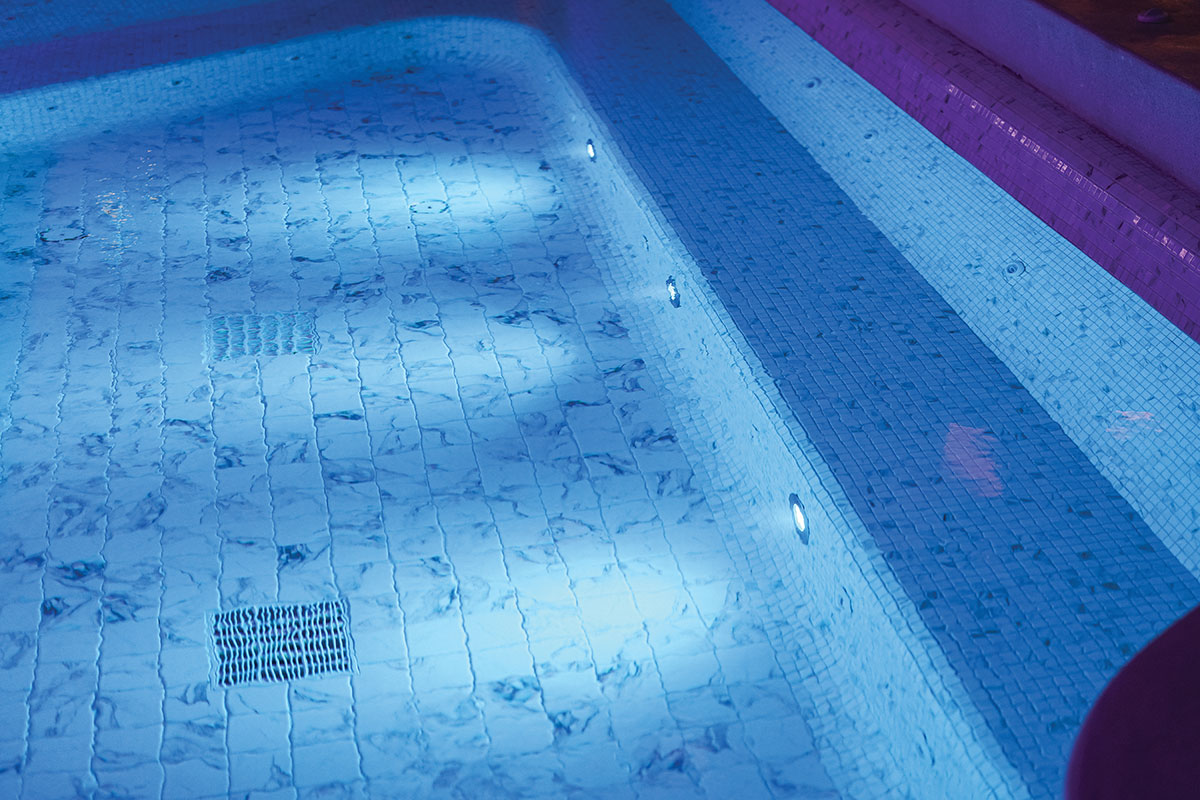Installing an incompatible wet-niche swimming pool luminaire (lighting fixture) into the forming shell in the wall of a swimming pool or spa can increase the risk of electric shock or injury to the users. The luminaire may physically fit into the forming shell, but the combination may not meet the applicable safety requirements.
Manufacturers of listed forming shells that mate with one or more listed wet-niche swimming pool luminaires intend the forming shells and luminaires to be used only in specific combinations. How does one know which wet-niche luminaire is intended to be used in a particular forming shell? The listed forming shell and listed wet-niche swimming pool luminaire are both marked to identify the proper combinations.

Photo 1. Forming shell in pool wall.
The listed luminaire bears a marking that identifies the specific forming shells with which the luminaire may be used. Similarly, the listed forming shell bears a marking that identifies the luminaires with which the forming shell may be used. These markings are required to be located where they can be viewed during luminaire installation: on the interior surface of the forming shell and on the exterior of the luminaire. These markings are part of the requirements in the Underwriters Laboratories Standard for Safety for Underwater Luminaires, UL 676.
This marking information is included in the UL Guide Information for Swimming Pool and Spa Equipment under the product category Fixtures, Lighting and Fixture Housings (WBDT) located on page 108 in the 2002 UL General Information Directory for Electrical Construction Equipment Directory (the White Book). This information can also be accessed on the internet on UL’s Online Certification Directory at www/ul.com/database and clicking on the Category Code/Guide Information search function and entering the category code WBDT.

Photo 2. Flexible cord coiled around wet-niche luminaires as it is installed in the forming shell.
What are the safety risks of using the wrong combination of luminaire and forming shell?
Compromised luminaire mounting. A luminaire not intended for a particular forming shell may not mount as securely as required. Although the mounting features of many luminaires and forming shells may appear to mate properly, the critical dimensions of certain features may not be compatible. Exact dimensions and the relative position between mounting brackets and fasteners, and the thickness, size, or shape of the involved parts often critically affect how securely a luminaire is mounted in the forming shell. UL evaluates the compatibility of specific luminaire/forming shell combinations.
If the luminaire does not securely mount at all intended securement points on the luminaire and forming shell, normal mechanical stresses encountered during pool usage (water motion and contact by pool users) may lead to loosening or failure of one or all of the mounting features. The luminaire may fall out of the forming shell or may be readily pulled from the forming shell by a pool user. If this occurs, multiple safety risks become more likely.
- Risk of drowning partially attributable to user entanglement.A pool user may get one or both legs entangled in the now loose, flexible cord, which may cause him or her to panic, thus increasing the risk of drowning. Similarly, the user may have his hand, foot, hair, etc., trapped in the forming shell if the luminaire does not mate properly.
- Risk of electric shock due to unconfined flexible cord.UL 676 requires the flexible cords that are part of a wet-niche luminaire to be water resistant and to have a relatively thick jacket. When a flexible cord is properly confined behind a wet-niche luminaire in the forming shell, any electric current that may escape from a damaged flexible cord into the water will tend to be confined and collected in the volume of water behind the wet-niche luminaire and in the forming shell. The relatively small amount of electric current that may conduct into the user area of the pool water will be inherently low enough to not exhibit a risk of electric shock to a pool user. If a damaged or deteriorated flexible cord becomes accessible in the user area of the swimming pool, the magnitude of electric current escaping the flexible cord may present a significant risk of electric shock to the pool user.
- Risk of electric shock due to compromised electrical bond.Proper electrical bonding is required by Article 680 of the National Electrical Code, NFPA 70, to prevent voltage gradients in the pool, and the luminaire shall be bonded to the forming shell. The brackets and fasteners securing the luminaire to the forming shell are, in conjunction with the luminaire equipment grounding conductor, the bonding path to the pool bonding grid and branch-circuit equipment grounding conductor. Low bonding path impedance between the luminaire and forming shell is needed for the bonding grid to function as intended during an electrical fault condition involving the luminaire. If the bonding path impedance between the wet-niche luminaire and the forming shell is not sufficiently low, a voltage gradient may be created in the pool water that might increase the risk of electric shock for a pool user. Leakage current into the pool water from a luminaire with a fault may exceed the escape current density limits assigned to listed swimming pool luminaires that are associated with a reduced risk of electric shock to the pool user [600 microamperes per square centimeter in fresh water pools and 2.4 mA per square centimeter in sea (salt) water pools]. See sidebar for additional discussion of how the bonding path impedance between the luminaire and forming shell is critical in limiting this voltage gradient.

Photo 3. Luminaire installed as intended in forming shell.
A ground-fault condition in the luminaire should be sensed and interrupted by the ground-fault circuit interrupter required in 680.23(A)(3). Even so, 680.23(A)(1) requires that, even without the GFCI installed, there is to be no shock hazard with any likely combination of fault conditions during normal use.
- Risk of injury due to contact with empty forming shell.A pool user can readily get his or her foot or hand into a forming shell not adequately containing a luminaire. The brackets, terminals, and other parts inside and at the opening present a potential risk of a cut-type injury.
Overheated forming shell in low water condition. Many forming shells are formed mostly of plastic. During a low-water condition (where the water level is low enough to not immerse part or all of the luminaire), the non-immersed inner walls of the plastic forming shell may encounter excessive temperatures from the heat radiated off of the hot luminaire enclosure.
While listed luminaires and forming shells are tested to address this condition during a listing evaluation, only those specific luminaire and forming shell combinations identified by the manufacturers are confirmed not to create excessive temperatures on the plastic forming shell. A luminaire other than that which is specified for use with the forming shell may operate with hotter enclosure temperatures when not immersed, even with the same or less lamp wattage. Selecting the wrong luminaire may overheat the forming shell plastic. If the forming shell plastic begins to distort or deteriorate, the metal-to-metal joints in parts of the forming shell, or between the forming shell and the luminaire, may become compromised. This may affect the bonding path impedance and increase the risk of electric shock to the pool user as discussed above.

Photo 4. Pool illuminated by a wet-niche luminaire.
In the case of new installations, care should always be taken to confirm that the wet-niche luminaire and the forming shell are both marked for use with each other. The same markings must also be checked when replacing a wet-niche luminaire in an existing forming shell. Over time, a luminaire manufacturer may develop new luminaires or change model numbers. The correlation marking on the forming shell already installed in the pool wall may not identify newer generation luminaires. In this case of wet-niche luminaire replacement in an existing forming shell, care must still be taken to confirm that the correlation marking on the luminaire identifies the model of forming shell that it is to be installed in. If not, safety risks can develop. In the case of uncertainty, UL or the manufacturer may be contacted to verify suitability of the combination in question. Photo 4
For more information on wet-niche swimming pool luminaires as well as other types of swimming pool luminaires and equipment, access the UL Swimming Pool Equipment, Spas, Fountains and Hydromassage Bathtubs Marking Guide as well as other UL Marking Guides on the UL Regulators page at:http://www.ul.com/regulators/guides.htm.
Why a low impedance bond from a wet-niche luminaire to its forming shell and pool bonding grid reduces the risk of electric shock.
The equipment grounding conductor in the flexible cord of the wet-niche luminaire may be relatively small (as little as 16 AWG in accordance with the NEC), and may have a length of one hundred feet or more. The relatively small AWG and long length will result in increased impedance through the flexible cord equipment grounding conductor.
If the electrical bond between the luminaire and the forming shell is poor or absent, in an electrical fault condition within the luminaire this increased flexible cord impedance causes a relatively greater voltage potential between the dead metal of the luminaire and other dead metal connected to the premises’ equipment grounding conductor.
The supplemental equipment grounding conductor in the form of corrosion resistant metallic conduit connected to the forming shell or the 8 AWG copper conductor routed with the flexible cord in nonmetallic conduit provides a second, more conductive, path for fault current originating in the luminaire. If the luminaire securement does not provide an effective electrical bond to the forming shell, there is an equally ineffective electrical bond to the supplemental equipment grounding conductor.
Section 680.26 of the NEC requires essentially all of the dead metal within 1.5 m (5 ft) horizontally from the pool wall and the dead metal of equipment associated with the pool water circulating system to be connected to a low-impedance common bonding grid, using a solid copper conductor not smaller than 8 AWG. Likewise, the electrical impedance of the electrical bond from the dead metal parts of the wet-niche luminaire to the pool bonding grid must be low. UL 676 requires the impedance between dead metal parts of a luminaire and the 8 AWG pool bonding grid conductor connected to the applicable terminal on the forming shell not to be more than 0.020 ohm. For perspective, this is approximately the DC resistance of 10 m of solid 8 AWG uncoated copper conductor at 25oC, a relatively low value.
Wet-niche luminaires and forming shells can be fabricated to provide this low impedance. However, compromising the luminaire securement parts (due to use of the wrong luminaire/forming shell combination) can very readily cause a significant increase in this bonding path impedance. In some circumstances, if metal-to-metal connection is not achieved because of mutually inconsistent design features, it might even prevent the bonding of the dead metal of the luminaire to the forming shell (and, in turn, the bonding grid). Increasing use of plastic luminaire and forming shell face rings (bezels) raises this risk of a possible compromise or absence of a bond. During an electrical fault in the luminaire, increased bonding path impedance through the forming shell to the pool bonding grid can result in a voltage potential difference between the dead metal of the luminaire and other objects connected to the bonding grid. Such a voltage potential difference may cause electric current to conduct from the luminaire into the pool water, instead of through the forming shell to the pool bonding grid.











Find Us on Socials